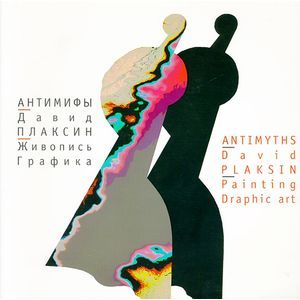Antimyths. Painting. Graphics
Please sign in so that we can notify you about a reply
The path of David Plaksina in art began with the Litohanvira "International. Today it is not difficult to reconnect about her theme, its size (70 x 1300 centimeters!), Meanwhile, it looks natural in the context of that time with its sincere sixties rhetoric, addicted to the enlarged form and with the rapid flowering of litogravory. The international could be a threshold for him in "Big Art" (he, in fact, was performed as an application for joining the union of artists), but did not. Life ordered in its own way - as always, sternly, but, probably, and wisely - dividing his work in art for two beds. Its machines performed by "for yourself", for quite a long time remained in the shade. The main defining position in the world has become a book art.
The 60s were the time of breaking the tempered stereotypes in art, and in the book - too. True, David Plaksina has little raised the passion for man-made graphics, which turned out to be one of the main tools of the update. Subsequently, he had been made more than once demonstrated on the pages of books a free and quite independent graphic form used in a wide style and genre range, up to illustrations. But then, he felt insufficiently confident, whether the frankness of the expression of the copyright began his inherent frankly for the creativity of the machine.
When contacting the easel painting changed, first of all, the structure of his work. Previously, the machine and book arts constituted two independent streams in it. Of course, there was some interaction between them and some interaction: Machine work was fueled by books, and not so much thematically as they might think how many plastically. Fantastic paintings of the turn of the 80s and 90s with them, as it were, materialized words ("Russia", "Terror", "people", and so on) Obviously occurred from the ABC graphic series (1989), in which the letters, the main The material of the book artist was interpreted as bulk forms in three-dimensional space.
Perhaps the artist managed to find his place in the labyrinth of modern postmodern art, cultivating artistic thinking as a game painted by global irony. If so, then he managed to keep himself and find saving wisdom. She is in the ability to perceive the imperfection of that absurd world, in which we fell away with happiness to live.
Edition in Russian and English
The 60s were the time of breaking the tempered stereotypes in art, and in the book - too. True, David Plaksina has little raised the passion for man-made graphics, which turned out to be one of the main tools of the update. Subsequently, he had been made more than once demonstrated on the pages of books a free and quite independent graphic form used in a wide style and genre range, up to illustrations. But then, he felt insufficiently confident, whether the frankness of the expression of the copyright began his inherent frankly for the creativity of the machine.
When contacting the easel painting changed, first of all, the structure of his work. Previously, the machine and book arts constituted two independent streams in it. Of course, there was some interaction between them and some interaction: Machine work was fueled by books, and not so much thematically as they might think how many plastically. Fantastic paintings of the turn of the 80s and 90s with them, as it were, materialized words ("Russia", "Terror", "people", and so on) Obviously occurred from the ABC graphic series (1989), in which the letters, the main The material of the book artist was interpreted as bulk forms in three-dimensional space.
Perhaps the artist managed to find his place in the labyrinth of modern postmodern art, cultivating artistic thinking as a game painted by global irony. If so, then he managed to keep himself and find saving wisdom. She is in the ability to perceive the imperfection of that absurd world, in which we fell away with happiness to live.
Edition in Russian and English
Cover:
Cover:Soft
Category:
- Category:Languages
- Category:Drawing & Painting
Paper:
Paper:Molded
ISBN:
ISBN:978-5-87417-256-5
No reviews found
